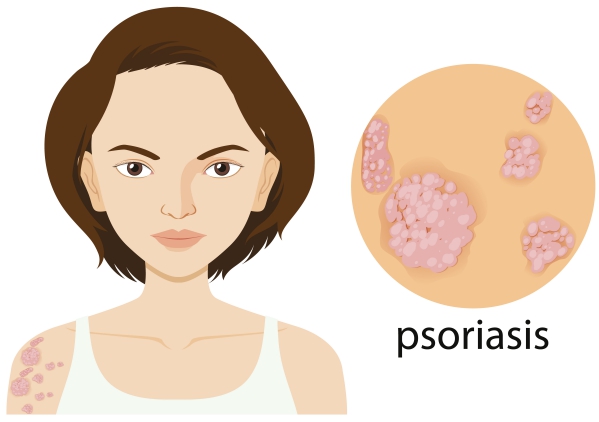Psoriatic arthritis, Psoriasis, Arthritis, Joint inflammation, NSAIDS, DMARDS
Description : Psoriatic arthritis is an inflammatory condition that affects several joints of the body with
Article Details :
What is Psoriatic Arthritis?
Psoriatic arthritis is an inflammatory condition that affects several joints of the body with coexisting psoriasis. Psoriasis is a skin condition that occurs when the cells found in your skin, called keratinocytes, proliferate too much causing an accumulation of skin cells. This accumulation manifests as white plaques on the skin. It can arise in several areas of the body. Psoriatic arthritis is the most common seronegative (meaning that blood tests are negative) inflammatory joint condition present in people with psoriasis. One of five people having psoriasis also have psoriatic arthritis.
Studies have shown that psoriatic arthritis is more common in people with severe psoriasis compared to those with mild disease. When it arises in people aged above 60 years, the disease tends to have a more severe onset and a more destructive course compared to younger patients. The course of the disease is similar to psoriasis itself, that is, it comes and goes (waxing and waning pattern).
There are several types of psoriatic arthritis including:
- Asymmetrical oligoarticular arthritis: This is the most common type of psoriatic arthritis. It affects the finger and toes at first resulting in a typical “sausage” appearance of the digits. The knee is also commonly involved.
- Symmetrical polyarthritis: Also known as the rheumatoid-like pattern, this affects the hands, wrists, ankles and feet. However, rheumatoid factor is not present on blood tests.
- Distal interphalangeal arthropathy: In this type of psoriatic arthritis, the small joints of the fingers are involved. The nails are also commonly involved.
- Arthritis mutilans: In this rare form of psoriatic arthritis, there is bone destruction with severe finger deformation.
- Juvenile psoriatic arthritis: This type of juvenile psoriatic arthritis, as the name suggests, occurs in children. It accounts for 8-20% of joint inflammation in children.
What are the causes of psoriatic arthritis?
The exact mechanism through which the disease occurs is not well understood. There are several factors that may contribute in the development of the disorder. These include:
- Genetic factors: 40% of people with psoriatic arthritis have close family members with the same condition. There are certain genes that may increase your risk of having the disease.
- Immunologic factors: There are some substances that are released by your immune system that can initiate inflammation.
- Environmental factors: In some cases, viral or bacterial infections can trigger psoriatic arthritis. Trauma can also contribute in the development of the condition.
What are the signs and symptoms of psoriatic arthritis?
In 60-80% of patients, psoriasis is the main symptom that precedes psoriatic arthritis. Psoriasis appears as red skin patches with overlying white silvery scales. However, in some other people, the joint inflammation precedes the psoriatic skin involvement. The signs and symptoms of psoriatic arthritis include the following:
- Joint pain
- Joint stiffness
- Fatigue
- Nail changes: Beau lines, white lines, white dots, haemorrhages, thickening of nails
- Sausage-like fingers
- Joint deformation
- Inflammation of the eyes

How is the diagnosis of psoriatic arthritis made?
To make the diagnosis of psoriatic arthritis, your doctor will start by asking you a series of questions to know more about your symptoms. He/she will then proceed with a thorough physical examination to look for signs of psoriatic arthritis. Your doctor will particularly have to make the difference between psoriatic arthritis and rheumatoid arthritis which are two different entities, yet so alike. The following tests may be requested:
- Erythrocyte sedimentation rate: This is an inflammatory marker present in the blood. It is elevated in around 40% of people with psoriatic arthritis.
- C-Reactive protein: This is also an inflammatory marker that can be elevated in the case of psoriatic arthritis.
- Rheumatoid factor: This is a marker for rheumatoid arthritis. If you have psoriatic arthritis, this is likely to be negative. However, in a small percentage of people, it can be positive.
- Synovial fluid: Some of the fluid present in an inflamed joint can be collected for further analysis. This is likely to show the presence of inflammation in the case of psoriatic arthritis.
- Imaging: Imaging tests can be requested to have a look at the affected joints. This can reveal bone erosion or deformation. The most commonly requested imaging tests are X-rays, computed tomography (CT) scans and magnetic resonance imaging (MRI).
How is psoriatic arthritis managed?
The main goal of treatment is to control the inflammation present in the joints of the body. In most cases, the joint and skin involvement is treated simultaneously. Treatment options include the following:
- Non-steroidal anti-inflammatory drugs: These Read more







